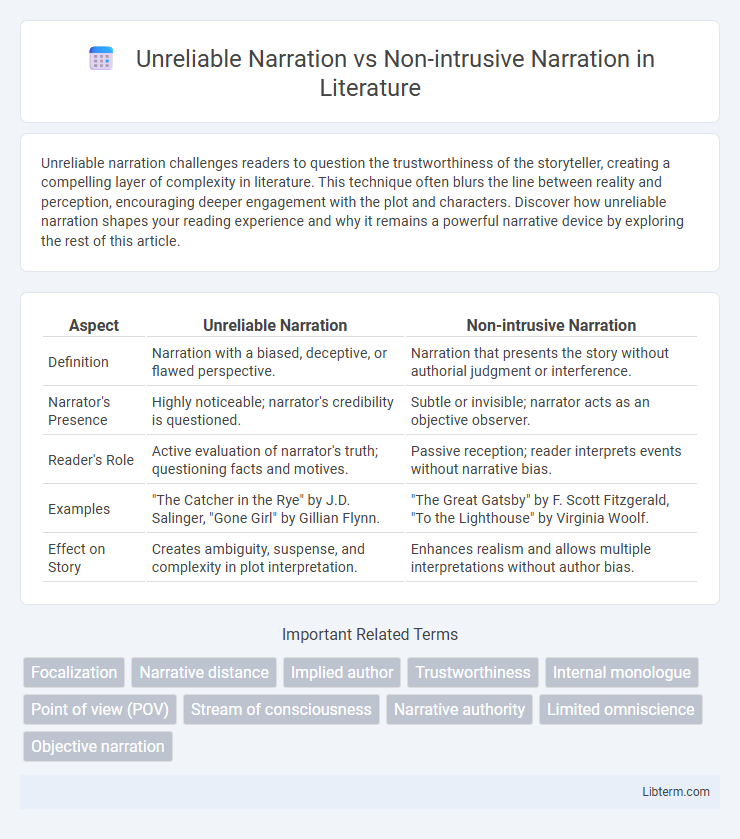Unreliable narration challenges readers to question the trustworthiness of the storyteller, creating a compelling layer of complexity in literature. This technique often blurs the line between reality and perception, encouraging deeper engagement with the plot and characters. Discover how unreliable narration shapes your reading experience and why it remains a powerful narrative device by exploring the rest of this article.
Table of Comparison
| Aspect | Unreliable Narration | Non-intrusive Narration |
|---|---|---|
| Definition | Narration with a biased, deceptive, or flawed perspective. | Narration that presents the story without authorial judgment or interference. |
| Narrator's Presence | Highly noticeable; narrator's credibility is questioned. | Subtle or invisible; narrator acts as an objective observer. |
| Reader's Role | Active evaluation of narrator's truth; questioning facts and motives. | Passive reception; reader interprets events without narrative bias. |
| Examples | "The Catcher in the Rye" by J.D. Salinger, "Gone Girl" by Gillian Flynn. | "The Great Gatsby" by F. Scott Fitzgerald, "To the Lighthouse" by Virginia Woolf. |
| Effect on Story | Creates ambiguity, suspense, and complexity in plot interpretation. | Enhances realism and allows multiple interpretations without author bias. |
Understanding Unreliable Narration
Unreliable narration challenges readers to discern truth amid conflicting or biased storytelling, often revealing the narrator's psychological state or intentional deceit. This technique engages audiences by creating ambiguity and requiring critical analysis of the narrative's credibility. In contrast, non-intrusive narration presents events objectively without authorial intervention, allowing the story to unfold naturally without questioning the narrator's trustworthiness.
What Defines Non-intrusive Narration?
Non-intrusive narration is defined by its subtle presence, allowing the story to unfold without overt commentary or judgment from the narrator. It prioritizes an objective viewpoint, presenting events and characters' actions without bias or explicit interpretation. This narrative style contrasts with unreliable narration by maintaining transparency and trustworthiness while remaining unobtrusive in shaping the reader's perception.
Key Differences: Unreliable vs Non-intrusive Narrators
Unreliable narration involves a narrator whose credibility is compromised, often leading readers to question the truthfulness or accuracy of the story being told, which creates ambiguity and layered interpretations. Non-intrusive narration, by contrast, features a detached and objective narrator who presents events and characters without editorializing or influencing the reader's perception, allowing the story to unfold naturally. The key difference lies in how unreliable narrators actively manipulate or distort the narrative, while non-intrusive narrators maintain neutrality and transparency.
Literary Techniques in Unreliable Narration
Unreliable narration employs literary techniques such as contradictory statements, selective memory, and biased perspectives to challenge the reader's trust and create narrative ambiguity. Techniques like inconsistent details, contradictory dialogue, and revealing inner thoughts expose the narrator's limited or distorted viewpoint. These methods actively engage readers in interpreting the truth, contrasting with non-intrusive narration's objective, transparent storytelling style.
The Role of Trust in Narration
Unreliable narration challenges the reader's trust by presenting biased, incomplete, or deceptive perspectives, creating ambiguity around the truth of the narrative. Non-intrusive narration maintains a neutral, transparent voice that allows readers to interpret the story without the narrator's overt influence, fostering a straightforward trust in the account. The role of trust pivots on the narrator's credibility, significantly affecting how engaged and critical the audience becomes when discerning the story's reality.
Reader Engagement with Unreliable Narrators
Unreliable narration intensifies reader engagement by provoking critical analysis and active interpretation, compelling readers to question the truth and reconsider the story's events from multiple perspectives. This technique creates suspense and emotional investment as readers unravel discrepancies and hidden motives within the narrator's account. In contrast, non-intrusive narration offers a more objective viewpoint, allowing readers to form independent judgments without overt narrative bias or manipulation.
Subtlety and Objectivity: Non-intrusive Narration Explained
Non-intrusive narration maintains a subtle, objective tone by presenting events and characters without overt commentary or bias, ensuring the reader forms interpretations independently. Unlike unreliable narration, which intentionally distorts or withholds information to influence perception, non-intrusive narration prioritizes clarity and neutrality, offering a transparent depiction of the narrative world. This approach enhances immersion by minimizing the narrator's presence, allowing the story's details to speak for themselves through precise and restrained language.
Examples of Unreliable Narration in Literature
Unreliable narration shapes readers' perceptions through biased or deceptive narrators, as seen in literary classics like "The Catcher in the Rye" by J.D. Salinger and "Gone Girl" by Gillian Flynn, where Holden Caulfield and Nick Dunne skew reality with their subjective perspectives. This technique contrasts with non-intrusive narration, which maintains an objective, detached voice, allowing the story to unfold without the narrator's subjective influence. Key examples highlight how unreliable narrators create suspense and deepen character complexity by obscuring truth and prompting readers to question the narrative's authenticity.
The Effect on Storytelling and Reader Perception
Unreliable narration disrupts the reader's trust, creating suspense and prompting active interpretation as the discrepancy between the narrator's account and reality unfolds. Non-intrusive narration maintains an objective perspective, allowing readers to immerse themselves in the story without bias, fostering a more seamless and authentic connection to events. The choice between these narration styles significantly shapes storytelling by either challenging reader perception through ambiguity or enhancing clarity and emotional resonance through neutrality.
Choosing the Right Narration Style for Your Story
Choosing the right narration style significantly impacts how your story engages readers and conveys truth. Unreliable narration challenges readers to question the protagonist's perspective, creating suspense and deeper psychological complexity, while non-intrusive narration offers an objective, immersive outlook that lets the plot unfold naturally without authorial intervention. Consider your story's themes and desired reader experience to select a style that enhances narrative tone, trust, and emotional connection.
Unreliable Narration Infographic

 libterm.com
libterm.com